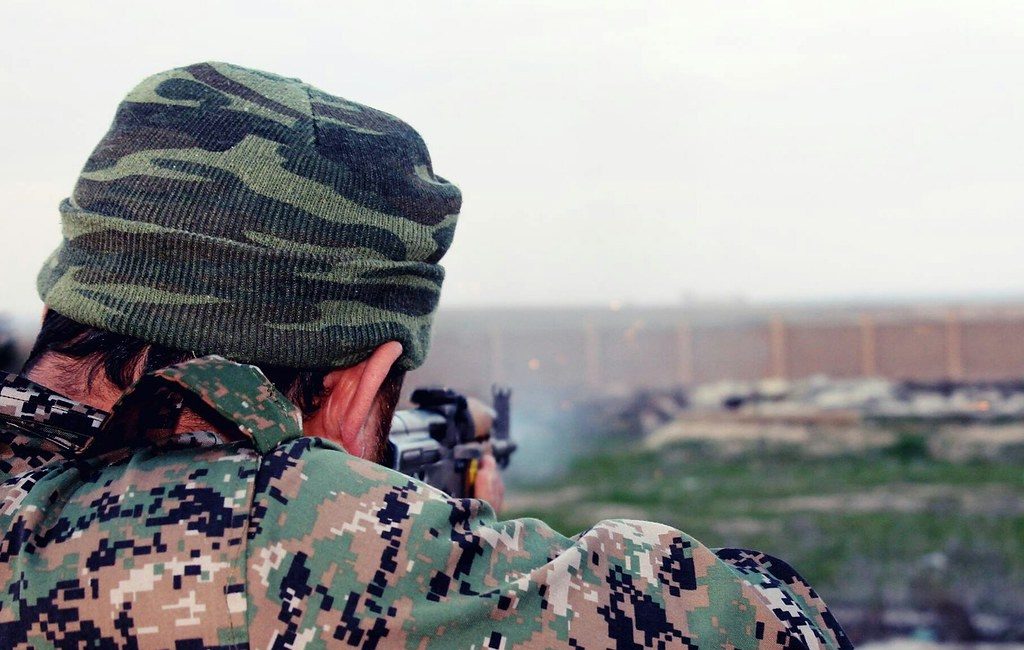As Turkey has launched military operations within Syria, principally targeting Syrian Kurds, it is worth understanding why and how we have reached this situation.
Out of the many ‘factions’ that have emerged from the fragmentation of the Syrian state with the ongoing conflict since 2012, there is one local actor that has been able to carve out for itself a space as a protagonist: the Syrian Kurds.
With the power vacuum created by the progressive defeat of ISIS on the ground and the retreat of Bashar Al-Assad's army, in 2016 they have been able self-proclaim an autonomous region named the Democratic Federation of Northern Syria (DFNS), also known as the ‘Rojava’ in the hopes of obtaining the decades-long objective of a constitutional recognition of Kurdish rights and democratic autonomy of Kurdish people.
The presence of a Kurdish political faction, the PYD under the umbrella coalition known as the TEV-DEM, along with a well-trained armed force, the YPG, has allowed the Kurds in Syria to obtain enough military resilience and international political recognition that has made of them one of the key regional players.
A Tacit Collusion
In 2012, as Assad was rapidly losing ground to jihadists and rebel factions, the Syrian regime needed to mobilize its armed forces to protect Damascus’s more exposed southern and eastern flanks. According to several analysts what this amounted to was a form of tacit, and later more evident, collusion of the PYD with the regime. [1]
The PYD was able, unlike other Kurdish groups, to position itself to the eyes of the regime as a militarily reliable combat force, with an anti-Turkish standing and an aim of seeking greater autonomy while remaining within the confines of a unitary Syrian state. Through a strategic lens striking a deal with the PYD was a convenient bet. Having a Kurdish-controlled enclave to the northeast fighting ISIS would alleviate Assad from the jihadist menace and also hinder Turkish support for Syrian opposition groups moving through the porous border.
The Kurds also had key interests in maintaining an open relationship with the regime. Logistically, given that Turkish troops soon sealed off the region’s land borders, the regime allowed Qamishli airport to be used by Kurds in Rojava as an aerial access point to Damascus, Latakia and Lebanon.[2]
As also stated by Asya Abdullah, PYD co-chair: “We believed this from the start, and we saw the Syrian regime as the core of the problem in Syria, but also as a part of the solution.”[3]
It does not come as a surprise therefore if in this time of need to deal with Turkish aggression, the YPG and SAA have come to a military agreement to fight jointly on Syria’s northern border.
Western Intervention: Boosting YPG Capabilities
The fight against ISIS was critical to Kurdish territorial expansion and in the establishment of their cantonal system.
While the YPG was able to liberate key cities under jihadi controlled territory, namely the strategic city of Tell Brak, and of Kobane (1/15) it is only since 2015, with the official entrance of the US-backed coalition support and airstrikes that it was able to achieve a substantial impetus to unify the envisaged Rojava cantons of Afrin, Jazira and Cizîrê.
The US strategic objective, especially once prospects of regime change were seen to be diminishing, was one dedicated to containing ISIS.[4] The PYD/YPG was the best alternative for the US to achieve such a goal without overly involving its own troops. This came in the form of financing and re-organizing the military disposition of the YPG by integrating other Arab and Syriac Christian militias, to form a professional army in Northern Syria that would fight under the banner of the SDF.[5]
Since then the US objective has been that of assuring the integral functioning of the SDF while maintaining political inclusion of all forces under the SDF structure.[6]
While this attempt naturally came with its misalignments, holistically the YPG has been able to gain substantial ground against ISIS.
What is clear is that with the US’s financial and logistical support the YPG gained a valuable military ally capable of guaranteeing its territorial expansion (acknowledging the regional presence occupied by Syrian Kurds) while shielding it from large and open confrontations with Turkish and regime forces.
It is therefore evident how any scaling back of US support will be critically detrimental to the viability of the SDF security architecture and complicate the advance of the SDF.
Russian Intervention: Appeasement and Mediation
However, the PYD too has largely benefited from Russia and enjoys rather good relations with the country although its strong links with the US has made it a double-edged sword, forcing Russia to play a delicate balancing game in Syria.
The PYD has had a political representation office in Moscow since 2016. Russia has opened several diplomatic channels and allowed for the political inclusion of Kurds on numerous occasions at the Russian-brokered Astana talks, which act as a parallel platform of dialogue to the UN-sponsored Geneva talks.[7]
The biggest benefit the PYD provided Russia initially was its anti-Turkey standing especially when it viewed Turkey as a direct opposer of the Assad regime, almost provoking a direct military confrontation after the downing of a Russian fighter jet. However, the progressive strengthening of US influence through the Kurds, has called for a realignment between Russia and Turkey for strategic containment purposes.
Indeed, the Turkish military operations Olive Branch and Euphrates Shield that brought to the capturing of Afrin and other areas in Northern Syria under the Rojava administration, came to be seen by the PYD above all as a Turkish aggression with Russian consent.[8]
At the same time, in trying not to excessively upset the power balance with the PYD/YPG and prevent Erdogan from further infiltration within Syrian territory, Russia has created de-escalation zones acting as practical buffer zones to protect the YPG using Syrian regime forces right after Turkey-backed opposition forces defeated Daesh and reached Manbij.[9]
Therefore, through Russian involvement, the PYD has been able to further its legitimacy and condition as an established actor. With American, Russian and inherently Syrian consent the YPG has been able to insulate itself from the Turkish threat, which remains the primary adversary of the PYD in the conflict, especially now that the ISIS threat has been largely quelled.
Turkey: A declared enemy
While the Rojava has seen important developments in transforming itself from a fringe movement to a substantial armed element in the war, its position remains precarious and is far from being a consolidated entity.
This is primarily because Turkey is determined to continue to undermine any formation of Kurdish autonomy, which it sees as a pretext for the creation of a wider independent Kurdistan.[10]
Turkey makes no distinction between the PKK (considered to be a terrorist organization by both the USA and EU) and the PYD and sees the emergence of a well-backed power as a direct threat to its territorial integrity and national security interests.[11]
However, while Turkish military capacities continue to far outweigh those of Syrian Kurds, the Turkish strategy comes with its perils. Turkey risks entrenching itself in a protracted war that in the long-run may undermine the international and domestic credibility of the President itself if he is not capable of achieving his stated objectives. Accelerating the resolution of the Syrian conflict would ultimately require Turkey to come to a political understanding with the PYD.
However, any form of appeasing the Syrian Kurds would project a weaker image of Erdogan’s intransigent stance towards PKK insurgents whom he is fighting at home.
An uncertain future
The survival of the ‘Rojavan’ project and its ambitions will be inevitably conditioned by the willingness of great powers (namely Turkey, Russia, Iran, US) and Assad, who previously voiced approval for a Syrian Constitutional Committee, comprising Kurdish representatives.
These prospects have for the moment faded as talks have been quelled in favour of rifles.
Gorgio Trichilo
[1] Sary, Ghadi, Kurdish Self-governance in Syria: Survival and Ambition, In: Chatham House: Middle East and North Africa Programme, September 2016, pp. 8
[2] Ibid, pp.15
[3] Ibid pp.9
[4] Holterman, Jay, Syrian Kurdish Autonomy: A Decisive Strategy for Bashar al-Assad, Joint Military Operations Department Naval War College USMC, 30 October 2015.
[5] Reuters, The conflict in Syria: US planes drop weapons for fighters fighting state organization in Hasaka, In: BBC News, 12 October 2015.
[6] Statement of General Lloyd J. Austin III, Commander of U.S. Central Command, before the Senate Armed Services Committee on Operation Inherent Resolve,” 16 September 2015
[7] Syria talks led by Russia, Iran and Turkey revived in Sochi, In: Al Jazeera, 30 July 2018.
[8] "We know that, without the permission of global forces and mainly Russia, whose troops are located in Afrin, Turkey cannot attack civilians using Afrin airspace," a PYD leader statement said.
[9] Taşkömür, Fatima, Russia’s PYD Game in Syria, In: TRT World, 7 November 2017
[10] Vita, Lorenzo, Trump sguinzaglia Erdogan: “In Siria, la Turchia farà il resto”, In: Gli Occhi della Guerra, December 22 2018.
[11] Chiaruzzi, Michele, L’offensiva Turca contro i Curdi, In: Atlante Treccani – Istituto della Enciclopedia Italiana, 28 January 2017


